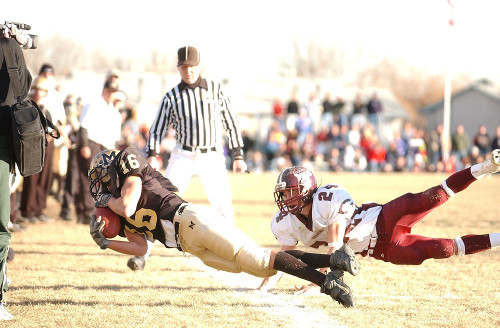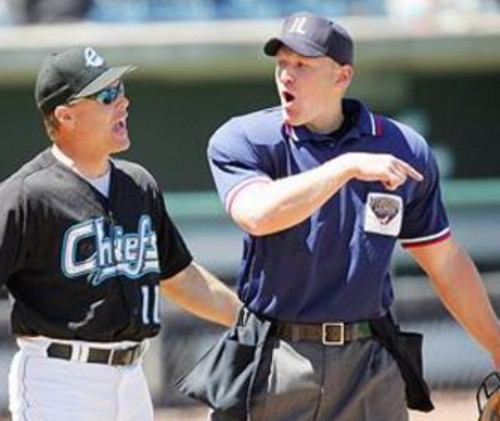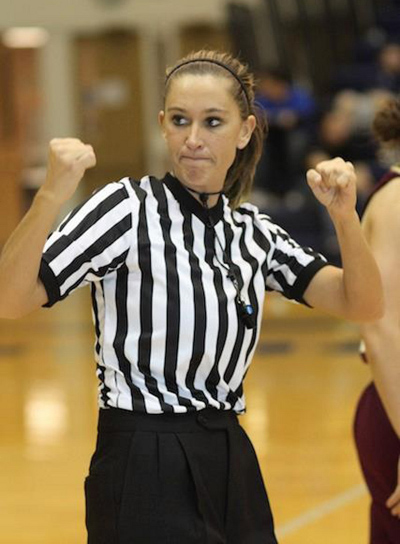
The group of approximately 50 officials from the Capital Area Officials Association (CAOA) in Lansing, Michigan, watched the same high school football play repeatedly for nearly a half hour at one of its regular Monday meetings.
There was spirited discussion as to whether the play resulted in a touchdown or fumble. Opinions flowed as to how their fellow officials – some of whom were also in the room that night – might have positioned themselves differently, focused on keys differently, reacted differently.
And, at the end of nearly 30 minutes, no definitive conclusion was reached.
“Maybe that’s the best we could do with a crew of five,” CAOA Executive Director Mike Conlin, himself an NCAA Division I football and baseball official, said that night. “But, what we can do is be aware of what part of the field the snap is taking place, and expect these situations on every play. Go over your keys in your head on every play. Be prepared.”
While officials continue to gather at regular association meetings to discuss mechanics, case plays and philosophies as they always have, the dynamics of these meetings have drastically changed in the past few years.
Dry-erase boards and paper handouts have yielded to projected PowerPoint presentations and video, making the curriculum more engaging and productive. There’s no better learning tool than watching clip after clip, and no better way to critique one’s own performance than to be able to watch it.
Dave Uyl, a former professional baseball umpire who now works NCAA Division 1 baseball and Division III football, spent a year-and-a-half as an associate editor for Referee, the monthly “Holy Grail” for officials nationwide.

Dave Uyl
“Just during my time there, we noticed a great increase in the number of high school officials associations using video on a regular basis at their meetings,” noted Uyl. “Without a doubt, the best meetings are those in which video is incorporated. It is so much more valuable to be able to break down plays and evaluate mechanics on the screen. It’s one thing to read a rules book, but another to be able to look at plays.”
The Genesee County Coaches and Officials Association is another of the Michigan associations at the forefront of the video vortex.
“We use a lot of video in our training. We can take examples and break them down at any speed we wish and present that to the group. We find that it keeps the attention span of our officials much better if they are visually engaged at our meetings instead of just listening to lectures,” said Steve Tannar, who has been to his share of meetings with the Genesee group as a five-sport official.
Jeremy Valentine, football officials coordinator for the MHSAA’s Southeastern Conference and a five-sport official himself for the Huron Valley Officials Association, has noticed that the effects of video can vary amongst officials.
“The ability to watch yourself on film has been very helpful to a number of officials at a variety of experience levels,” Valentine said. “However, some officials may be intimidated to watch themselves on film for fear of what they may actually see.”
Tannar offers an alternative for those who might be camera-shy, but adds that the road to improvement – as in any endeavor – is to make mistakes and recognize them; whether alone, or in front of a group of peers.
“We typically don't use a ton of our own people in video presentations,” Tannar said. “We prefer not to put our guys on the spot, so anonymous video works best for us. That doesn't mean we never do it though. I've been up on the big screen for the whole room to see. There’s nothing wrong with a little humility from time to time.”
In the Capital Area Officials Association, nearly all of the video shown at its meetings involve member officials. Dan Renner has taken the reins of the video program during football season through hudl.com. Area schools post their contests to hudl, and Renner alerts CAOA members when new clips and games are online for review.
“Before hudl, we’d get six or seven DVDs per season from officials who were off on a given night and then went to shoot a game,” Renner said. “It’s amazing how quickly some of the games are up and posted now. We use it as a tool. We historically know what types of offenses schools in the area run, but for non-conference games it gives us an idea what those schools run, so we can pregame a bit better.
“You just have to understand that in an immediate-feedback world, if you boot a call during a game, you’ll come to next association meeting and everyone has seen it and everyone knows. Film doesn’t lie, and you are putting yourself out there each time you go out.”
Eric Wills Jr., like Renner, is a young official who just completed his first year at the NCAA Division III level. He has no doubt that his exposure to video accelerated his path.
“Sites like hudl really help young officials see snaps and get experience,” Wills said. “I watch my pre-snap keys, break down my zone, observe the dead ball officiating. Video allows us to get reps just by watching more snaps. I spend about two to two-and-half hours a week watching film and discussing it with other officials. Fellow officials are our best critics and that’s how we get better.”
Video has certainly added a new means by which people are able to capture officiating mistakes. Often times, the officials are exonerated by the tales of the tape. In either case, class is always in session today.
“We watch clips in locker room after game as a crew. If we see something we think was questionable, we can send it to our supervisor with an explanation,” said NCAA Division 1 basketball official Meghan Joseph. “A coach can also send a clip to our video coordinator, who will send us a copy. If further conversation is needed, the supervisor, video coordinator and officiating crew might have a conference call. There is definitely more accountability with video.”

Meghan Joseph
At the high school level, while most coaches are glad to assist in officials’ quest for improvement, some remain reluctant to share video; until a call is perceived to go against them.
“For the most part, the coaches thought it was great that we wanted to continuously improve,” said Renner. “There are a few schools that don’t want to share the video and are afraid with hudl it’s just a couple clicks away. Well, if you think about it, every game on Saturday and Sunday can be recorded by millions of people through basic cable with DVR.”
To be sure, no matter how protective some try to be, video of almost anything, anytime, is out there, waiting for more sets of eyes. And most fail to realize that high school contests remain – above all – extensions of the classroom. High school sports are educational business, not big business.
“The stakes for high school sports are lower. Fortunes will not be made or lost by a blown call in a high school game. In high school sports, it’s education more than business,” said MHSAA Executive Director Jack Roberts. “And if we do the education thing right, we seize the teachable moment.”
It is no surprise that some of the students with the greatest thirst for such knowledge in educational athletics are the officials. Their advancement and success largely depends on their rules knowledge and performance. Technology plays an enormous role in an official’s ability to improve both.
From online rules meetings, to online forums and video portals, to regular association meetings and video review, technology continues to provide a bounty of learning tools for the hungriest officials.
Not surprisingly, those with the biggest appetites are often the youngest officials, for whom technology is as natural as breathing.
“I can’t think of a time that technology has had a negative impact on officiating,” said Kyle Bowen of Detroit, currently a Grand Valley State University student who works basketball. He first registered with the MHSAA in 2008 through the Legacy program. “Technology has been super beneficial because I am constantly watching training videos, play clips, and anything else that can be helpful to me as an official.”
Luke Bowman, a Central Michigan University student from Jackson, first registered for football, basketball and baseball in 2007. From the registration process to his growth as an official, technology has helped pave the way.
“Watching game video helps things become clearer when we see similar plays on the field. Technology continues to become cheaper and more readily available,” said Bowman, who recently officiated his first NCAA Division III football contest.
Associations such as the CAOA have used membership dues to purchase video equipment and software. The Association gives subvarsity officials a small stipend to record varsity games, and in turn the newer official often times will travel with the crew and be a part of the pregame and postgame discussions.
“It’s just another way to involve our newer people and get them excited about officiating,” Conlin says. “It’s a motivational tool and a learning experience. Anyone in our association is welcome to travel with a veteran group or sit in on a pregame, and we’ve seen more of that in recent years.”
Rob Kaminski
Rob Kaminski is the website and publications coordinator for the Michigan High School Athletic Association and is a member of the NFHS Officials Publications Committee.
Most Recent Articles
- nfhs news NFHS Learning Center Delivers 25 Millionth Course
- Track & Field/Cross Country article Effective Communication with Athletes and Coaches
- nfhs news Player Equipment Changes Highlight 2025 High School Football Rules Revisions
- Player Equipment Changes Highlight 2025 High School Football Rules Revisions
- nfhs news Judgment Call on Second Contact Eliminated in High School Volleyball






